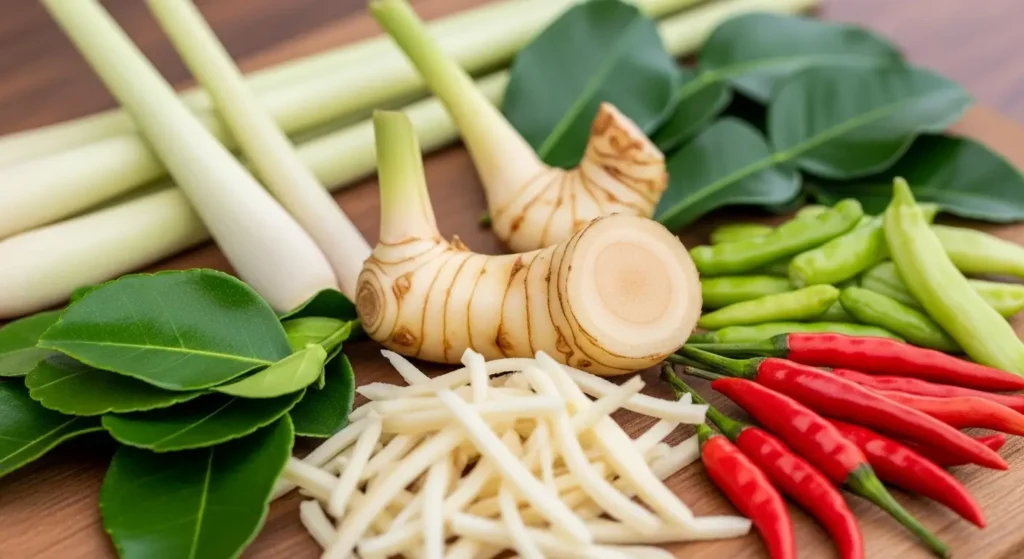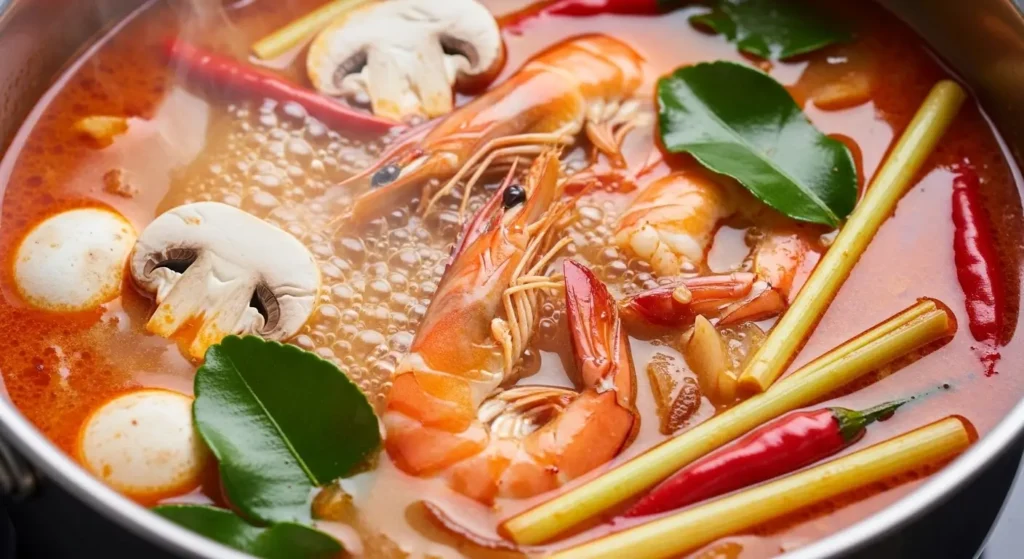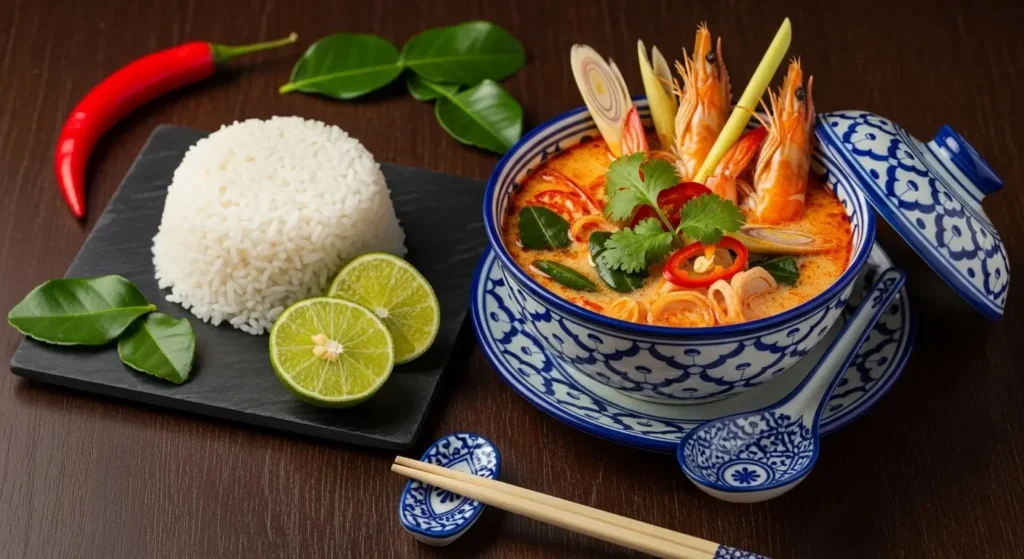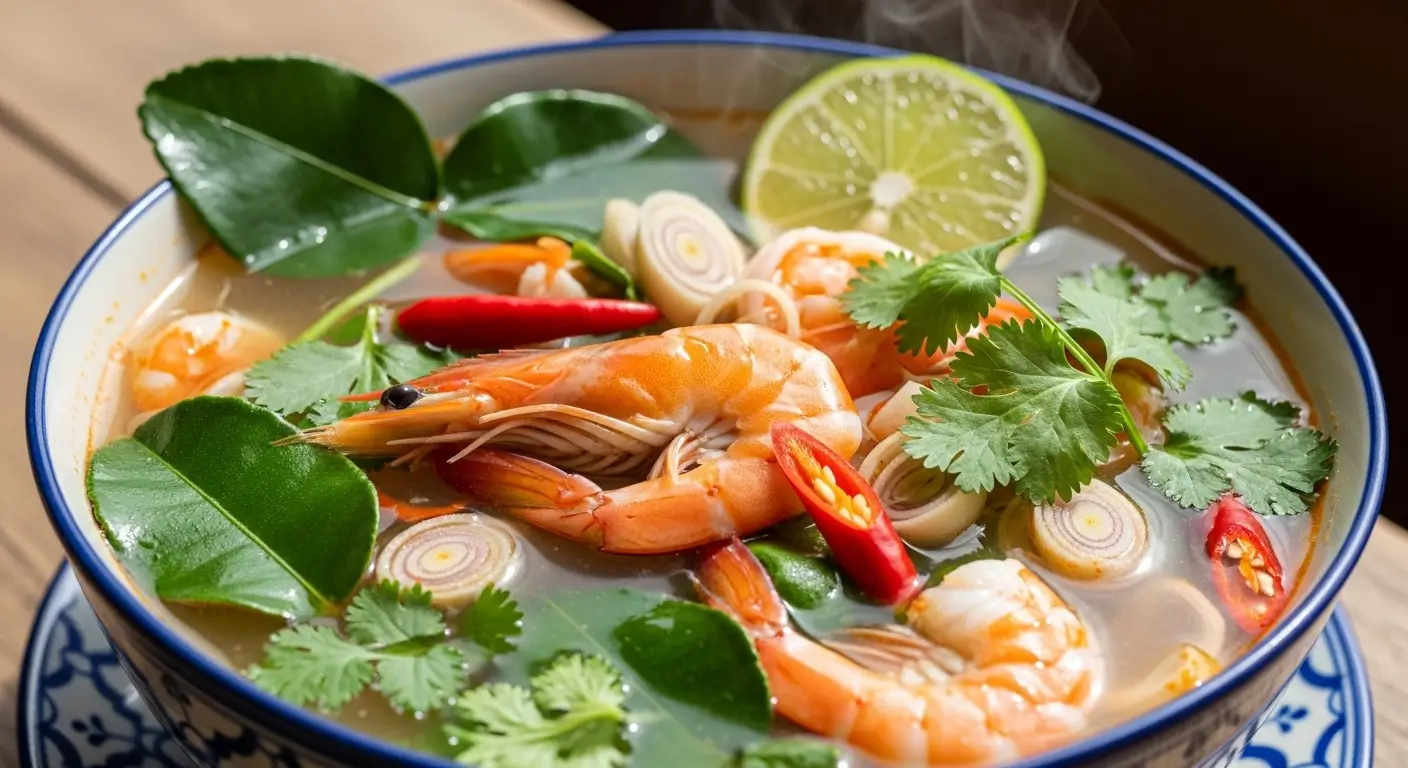Authentic Tom Yum Recipe – A Flavorful Thai Soup You’ll Love
When it comes to Thai cuisine, few dishes capture its vibrant essence quite like the Tom Yum recipe. Known for its bold blend of spicy, sour, salty, and slightly sweet flavors, Tom Yum soup is a signature staple across Thailand and a favorite worldwide. This dish perfectly reflects the Thai philosophy of balance in taste — where each ingredient complements the other to create a symphony of flavor in every spoonful.
In this article, we’ll dive deep into everything you need to know about making an authentic Tom Yum recipe at home — from its fascinating history and traditional ingredients to health benefits and expert cooking tips. Whether you’re a seasoned chef or a curious beginner, this guide will help you master this aromatic, soul-warming soup step by step.
Learn more about Asian cuisine with our Delicious Moroccan Chicken Tagine for another flavorful global dish.
Table of Contents
Introduction to Tom Yum Soup
What Is Tom Yum Soup?
Tom Yum (also spelled Tom Yam) is Thailand’s most famous soup, widely known as a hot and sour soup typically made with shrimp, chicken, or mixed seafood. The name itself breaks down simply — “Tom” means boiling, and “Yum” refers to the spicy and sour flavor profile of the soup. What makes the Tom Yum recipe unique is its combination of aromatic herbs like lemongrass, galangal, kaffir lime leaves, and Thai chilies, which infuse the broth with a refreshing, citrusy essence.
Unlike other soups that rely heavily on cream or butter, Tom Yum maintains a light yet flavorful broth, making it a refreshing meal that’s satisfying without being heavy.
The Cultural Significance of Tom Yum in Thai Cuisine
In Thailand, Tom Yum isn’t just a dish — it’s a national symbol. The Tom Yum Goong (shrimp version) represents the balance of flavors central to Thai food philosophy. It’s a dish commonly served in family gatherings and street food stalls alike, offering comfort and connection through shared bowls of steaming broth.
Thai people believe food is not only nourishment but also medicine. The ingredients in a traditional Tom Yum recipe are known for their natural healing properties — from the anti-inflammatory effects of lemongrass to the digestion-aiding galangal. This makes the soup both a culinary delight and a natural remedy.
Why Tom Yum Recipe Is Loved Worldwide
So, what makes Tom Yum such an international favorite? It’s simple: flavor, versatility, and health benefits. The soup strikes a perfect balance of spice, tang, and freshness that excites the palate. It can be customized with shrimp, chicken, mushrooms, or tofu, making it suitable for almost any diet.
Its global popularity grew in the 1980s as Thai restaurants expanded across the world. Today, Tom Yum appears on menus from New York to Sydney, celebrated for its authentic Thai flavor and low-calorie profile.
Don’t miss our Seafood Salad Recipe if you love light and refreshing dishes packed with ocean flavors.
Quick Facts Table: Tom Yum Soup Overview
| Element | Description |
|---|---|
| Origin | Thailand |
| Main Flavor Profile | Spicy, sour, savory |
| Common Ingredients | Lemongrass, galangal, kaffir lime leaves, shrimp, fish sauce, lime juice |
| Cooking Time | 30 minutes |
| Popular Versions | Tom Yum Goong (shrimp), Tom Yum Nam Khon (creamy) |
| Health Benefits | Low calorie, rich in antioxidants, aids digestion |
Tom Yum isn’t just soup — it’s a sensory experience that combines heat, fragrance, and a burst of zesty flavors. Every spoonful tells the story of Thailand’s culinary heritage.
Looking for inspiration? Try our Bang Bang Shrimp Recipe for another spicy seafood delight inspired by Asian flavors.
The Origin and History of Tom Yum
Where Is Tom Yum Originally From?
The Tom Yum recipe traces its roots deep into the heart of central Thailand, particularly around the Chao Phraya River region, where freshwater shrimp and aromatic herbs were abundant. The word Tom Yum comes from Thai, where Tom means “to boil” and Yum means “a mix of spicy and sour flavors.” Together, they perfectly describe the essence of this iconic soup — a hot and sour broth simmered with herbs and seafood.
Tom Yum Goong (the shrimp version) is believed to have originated in households near the river, where shrimp was plentiful and often combined with locally grown herbs like lemongrass, galangal, and lime leaves. Over time, this home-cooked favorite evolved into a staple of Thai cuisine that’s now enjoyed around the globe.
Discover more flavorful dishes with our Peruvian Chicken Recipe — another international favorite bursting with spice and character.
Evolution of Tom Yum Over the Years
Initially, Tom Yum was a clear soup (Tom Yum Nam Sai) — simple, herbal, and naturally refreshing. As Thai cuisine grew in complexity, so did the soup. The addition of Nam Prik Pao (Thai chili paste) introduced a smoky depth, while later versions included a splash of evaporated milk or coconut cream, giving rise to Tom Yum Nam Khon, a creamier, richer variant.
By the 20th century, Tom Yum had spread throughout Southeast Asia, inspiring regional adaptations. In Malaysia and Singapore, for example, you’ll find versions that are slightly spicier or use seafood mixes. In Western countries, chefs have experimented by adding mushrooms, tofu, and even noodles — transforming it into a fusion comfort dish.
Thai Culinary Influence Around the World
Thailand’s culinary influence, especially through dishes like the Tom Yum recipe, has been a cornerstone of Asian gastronomy worldwide. The dish gained global recognition in the 1980s and 1990s when Thai restaurants began opening in major cities like Los Angeles, London, and Sydney.
Its global success can be attributed to its perfect balance of flavors — spicy, sour, salty, and sweet — something many cuisines strive to achieve. Today, Tom Yum is not only a restaurant favorite but also a homemade dish embraced by food lovers who crave authentic yet easy-to-make Asian meals.
It’s no surprise that UNESCO recognized Thai cuisine’s cultural significance, with dishes like Tom Yum representing the harmony of nature and nutrition.
Check out our Homemade Chicken and Gravy for another heartwarming comfort recipe that celebrates traditional cooking.
Timeline: The Journey of Tom Yum Recipe
| Era | Development |
|---|---|
| 18th Century | Tom Yum emerges as a local shrimp soup in central Thailand. |
| 19th Century | Becomes a national dish served in Thai royal kitchens. |
| 20th Century | Introduction of chili paste and creamy variations. |
| 21st Century | Global popularity; fusion versions appear in international restaurants. |
Over the years, Tom Yum soup has evolved from a regional river-side dish to a global culinary sensation. Its appeal lies in its simplicity, adaptability, and the unmistakable aroma of Thai herbs that awaken the senses.
Don’t miss our Delicious Asian Desserts to finish your Tom Yum meal on a sweet note.

Understanding the Unique Taste of Tom Yum
What Does Tom Yum Taste Like?
The first spoonful of Tom Yum soup is unforgettable. It’s spicy, sour, and slightly salty, with a subtle sweetness that ties it all together. The combination of chili heat, citrus tang, and fragrant herbs makes each sip vibrant and exciting.
Unlike creamy Western soups, Tom Yum has a clean, refreshing broth. The lemongrass adds a bright lemony note, while lime juice gives a sharp tang that awakens your taste buds. Every ingredient has a purpose — from galangal’s earthy depth to kaffir lime leaves’ floral aroma.
It’s this balance that makes the Tom Yum recipe such a beloved dish. No one flavor overpowers the others; instead, they work in harmony to create something uniquely Thai.
Check out our Delicious Ground Beef Crock Pot Recipe for another comforting meal full of bold, hearty flavors.
Balancing Spicy, Sour, and Savory Flavors
Tom Yum’s magic lies in its balance. Thai cuisine thrives on contrast, and this soup captures that perfectly. The chili paste (Nam Prik Pao) brings smoky heat, fish sauce adds saltiness, and lime juice delivers a punch of sour freshness.
Adding a bit of sugar may seem odd, but it’s essential — it rounds out the sharp flavors and keeps the soup smooth on the palate. This is how Thai cooks master balance, ensuring no single taste dominates the dish.
If you’re new to Thai cooking, remember this rule: taste, adjust, and taste again. Achieving harmony between spice, sourness, and salt is the secret to mastering Tom Yum at home.
Ingredients That Define Tom Yum’s Signature Taste
Authentic Tom Yum recipes rely on fresh herbs, not heavy seasonings. The key trio — lemongrass, galangal, and kaffir lime leaves — creates the unmistakable fragrance that defines the soup.
Lemongrass adds citrus brightness. Galangal, similar to ginger, adds warmth and depth. Kaffir lime leaves, with their floral zest, complete the base. Together, they transform simple broth into something extraordinary.
Other ingredients like Thai bird’s eye chilies, fish sauce, and lime juice enhance the intensity, while proteins like shrimp or chicken absorb the broth’s flavor beautifully.
Want to explore another dish that celebrates flavor balance? Discover our Garlic Parmesan Chicken Pasta — rich, creamy, and equally satisfying.
Quick Flavor Breakdown: Tom Yum’s Signature Notes
| Flavor | Ingredient | Description |
|---|---|---|
| Spicy | Thai chilies | Adds heat and depth |
| Sour | Lime juice, lemongrass | Provides tang and brightness |
| Savory | Fish sauce | Creates umami balance |
| Aromatic | Galangal, kaffir lime leaves | Infuses fragrance |
| Sweet | Palm sugar | Smooths harsh edges |
Each bowl of Tom Yum soup tells a story — one of balance, energy, and the essence of Thai cooking. It’s not just about flavor; it’s about how those flavors make you feel — refreshed, awake, and fully satisfied.
Don’t miss our Vegan Yum Yum Sauce Recipe for another sauce that packs umami power in every bite.
Step-by-Step Guide – How to Make Tom Yum Soup

Preparing the Aromatic Broth
The secret to a perfect Tom Yum recipe starts with the broth. Begin by filling a medium pot with 5 cups of water or stock. Add the sliced lemongrass, galangal, and kaffir lime leaves, then bring it to a gentle boil. This simmering step releases the essential oils and creates a fragrant, citrusy aroma that forms the soup’s foundation.
Let it bubble softly for about 10 minutes—don’t rush it. Overboiling can dull the flavors, so keep the heat low. Once your kitchen smells like a Thai street café, you’ll know it’s ready. Strain the broth if you prefer a clear base, or leave the herbs for a stronger infusion. Discover great ideas like our Greek Lemon Rice Soup Recipe for another zesty and soothing bowl.
Adding Proteins and Vegetables
Once your broth is ready, it’s time to add life to it. For a classic Tom Yum Goong, toss in cleaned shrimp, mushrooms, and tomatoes. Shrimp cooks fast—just 2 to 3 minutes until they turn pink. If using chicken, cook it for 5 to 6 minutes instead. Mushrooms soak up the broth and add a chewy texture that balances the shrimp’s sweetness. Cherry tomatoes are optional, but they bring a pop of color and a hint of acidity that complements the lime. Always cook in stages, not all at once, so every ingredient retains its texture. Don’t miss our Delicious Smoked Salmon Brine Recipe for another seafood technique worth mastering.
Finishing with Thai Chili Paste and Lime Juice
Once your proteins are cooked, stir in Nam Prik Pao (Thai chili paste). This step transforms the soup from mild to magical. The paste gives a smoky, slightly sweet depth and a beautiful orange tint. Follow with fish sauce for saltiness and a touch of sugar to balance the spice. The final—and most important—step is lime juice. Always add it last, after removing the pot from heat. Boiling lime juice makes it bitter, so timing is everything. Give it a quick taste; the soup should hit all the right notes—hot, sour, and savory, with just a whisper of sweetness.
Common Mistakes to Avoid When Making Tom Yum
Even the best cooks can trip up when making Tom Yum soup. One common mistake is overcooking the herbs—they’re meant to infuse, not stew. Another is adding lime juice too early, which can turn the broth harsh. Also, using bottled lime juice or dried lemongrass just doesn’t deliver the same brightness as fresh ingredients. Lastly, don’t oversalt with fish sauce; it’s powerful, and a little goes a long way. If your soup turns too spicy, add more broth or a dash of coconut milk to calm the heat. Perfection in Thai cooking isn’t about strict rules—it’s about tasting and adjusting as you go.
Tom Yum Soup Cooking Summary Table
| Step | Description | Key Tip |
|---|---|---|
| 1 | Simmer herbs in broth | Don’t overboil; keep it aromatic |
| 2 | Add proteins | Cook in stages for even texture |
| 3 | Stir in chili paste | Enhances color and smoky flavor |
| 4 | Add lime juice and fish sauce | Balance flavors right before serving |
| 5 | Taste and adjust | Aim for harmony of spicy, sour, and salty |
Serving Your Homemade Tom Yum Soup
Serve your Tom Yum recipe hot, with a side of steamed jasmine rice or rice noodles. Garnish with cilantro leaves, thin chili slices, or extra lime wedges for brightness. It’s best enjoyed fresh, though you can refrigerate it for up to two days. When reheating, avoid boiling—just warm gently to preserve the delicate flavors. The best part about making it at home? You control the spice, tang, and salt level to match your taste perfectly. Looking for another vibrant Asian dish? Try our Rasta Pasta Recipe, bursting with color and creamy Caribbean flair.
Expert Tips and Serving Suggestions
What Meat Is Best for Tom Yum Soup?
When it comes to protein choices, the Tom Yum recipe is incredibly flexible. Traditionally, shrimp (goong) is the star of the classic version, offering sweetness that balances the soup’s spicy-sour broth. Shrimp cooks quickly and absorbs the herbal flavor perfectly, which is why it’s the most popular choice. However, chicken is another great option if you prefer something heartier. Thinly sliced chicken breast works best—it stays tender and juicy without overpowering the aromatics. For seafood lovers, squid or mixed seafood adds extra depth, while for a twist, tofu can be used to create a light vegetarian version that still soaks up all those amazing Thai spices. Looking for another shrimp-based favorite? Try our Bang Bang Shrimp Recipe.
Perfect Pairings: Side Dishes and Drinks
The Tom Yum soup pairs beautifully with several sides. Jasmine rice is the traditional accompaniment, helping mellow the heat and soak up the flavorful broth. You can also serve it with Thai-style fried rice or a fresh papaya salad for contrast. For something lighter, steamed vegetables or spring rolls complement the soup’s intensity. Drinks matter, too. Thai iced tea or coconut water helps cool your palate between spicy bites, while hot green tea keeps the meal soothing and balanced. If you’re hosting a dinner, pair Tom Yum with crispy appetizers for a full Thai-inspired menu. Discover great ideas like our Delicious Bagelry Gluten-Free Bagels for a fusion twist on your side pairing.
Presentation and Garnishing Ideas
Presentation elevates your Tom Yum recipe from simple soup to restaurant-worthy delight. Use deep white bowls to highlight the rich orange color of the broth. Garnish with fresh cilantro leaves, thin chili slices, and a wedge of lime for brightness. If using shrimp, keep the tails on for a more authentic look.
For an extra touch, drizzle a little chili oil or sprinkle crushed peanuts on top—it adds texture and visual appeal. A few drops of coconut milk swirled into the broth can also make your Tom Yum Nam Khon look irresistibly creamy. Remember, we eat with our eyes first, and this soup deserves to be showcased beautifully. Don’t miss our Crispy Juicy Chicken Cutlets for another dish that’s as eye-catching as it is tasty.
Storage and Reheating Tips
Tom-Yum tastes best fresh, but you can store leftovers for later. Keep it in an airtight container in the refrigerator for up to two days. When reheating, do it slowly over low heat to preserve the delicate lime and herb flavors. Avoid microwaving too long, as it can make the shrimp rubbery or the lime taste bitter. If you plan to make it ahead, store the broth and proteins separately and combine them right before serving. This keeps everything fresh and flavorful. Check out our Homemade Chicken Taco Seasoning for another great prep-friendly kitchen staple.

Expert Cooking Tips Table
| Tip | Why It Matters |
|---|---|
| Add lime juice last | Prevents bitterness and keeps soup bright |
| Don’t overboil shrimp | Keeps texture tender and juicy |
| Use fresh herbs | Enhances aroma and authentic taste |
| Adjust spice gradually | Easier to control heat |
| Serve immediately | Keeps broth vibrant and fresh |
Making Tom Yum a Crowd Favorite
The Tom Yum soup is more than just a starter—it can be the highlight of your meal. For gatherings, serve it in small bowls or shot glasses as an appetizer. The mix of spicy and sour instantly wakes up the palate. If you’re planning a themed dinner, pair it with Pad Thai or Thai grilled chicken for a complete experience. For family dinners, keep the spice mild and let everyone add chili to taste. No matter the occasion, Tom-Yum never fails to impress—it’s simple, aromatic, and deeply comforting. Looking for inspiration? Try our Delicious Toll House Cookies for a sweet treat to end your Thai-inspired meal.
Conclusion: Bringing Authentic Thai Flavors Home
Mastering the Tom Yum recipe brings the spirit of Thai cooking right to your kitchen. This soup embodies everything Thai cuisine stands for — balance, freshness, and a celebration of natural flavors. From its zesty lemongrass aroma to the warmth of chili and lime, every spoonful tells a story of tradition and health. The best part is that it’s easy to adapt, whether you prefer it clear and spicy or creamy and comforting. So, the next time you crave something warm yet refreshing, skip takeout and make your own Tom-Yum at home. It’s fresh, flavorful, and full of heart. Looking for inspiration? Try our Easy Fish Food Recipes to Try at Home to continue your global cooking journey.
FAQs
What does Tom Yum taste like?
The Tom Yum recipe delivers a vibrant mix of spicy, sour, and savory flavors. Its base of lemongrass, galangal, kaffir lime leaves, and chilies creates an aromatic punch that’s both bold and refreshing. The sourness from lime juice balances the saltiness of fish sauce, while chili adds heat and excitement. Each spoonful feels layered — first a citrusy spark, then a wave of spice, and finally, a subtle sweetness. This harmony of flavors is what makes Tom-Yum one of Thailand’s most iconic dishes.
Is Tom Yum good for health?
Yes, Tom Yum soup is a powerhouse of nutrients and antioxidants. The herbs used — lemongrass, lime leaves, and galangal — are natural immune boosters. Chilies help improve metabolism, while shrimp or chicken provides lean protein. It’s low in calories, rich in vitamins, and supports digestion. Many nutritionists recommend it as part of a healthy eating plan because it’s both flavorful and light. The combination of heat, herbs, and lime juice can even help clear sinuses and detoxify the body.
Where is Tom Yum originated?
Tom Yum originated in central Thailand, near the Chao Phraya River, where freshwater shrimp and aromatic herbs were readily available. Local families first crafted it using local herbs and river prawns, creating what’s now known as Tom Yum Goong. Over time, the recipe spread across Thailand and neighboring countries, each adding unique touches while preserving the soul of the original. Today, it’s celebrated worldwide as the soup that best represents Thai culinary heritage.
What are the two types of Tom Yum soup?
There are two main types — Tom Yum Goong and Tom Yum Nam Khon. Tom-Yum Goong features a clear, spicy, and sour broth made with shrimp, perfect for those who love intense citrusy heat. Tom-Yum Nam Khon, on the other hand, includes coconut milk or evaporated milk, giving it a creamy texture and a mellower flavor. Both versions use the same base herbs, but their difference lies in texture and richness.
Is Tom Yum Chinese or Thai?
Tom Yum is unmistakably Thai. While Chinese cuisine has many flavorful soups, Tom-Yum stands apart as a distinct creation rooted in Thai culture. The use of lemongrass, galangal, kaffir lime leaves, and fish sauce are defining traits of Thai cooking. Even though it’s now served in Chinese and fusion restaurants worldwide, its origin, flavors, and ingredients remain authentically Thai.
What meat is best in Tom Yum?
Traditionally, shrimp is the top choice for Tom Yum because of its sweetness and quick cooking time. It pairs beautifully with the soup’s tangy and spicy notes. However, chicken works well too, offering a more filling, milder version. Some Thai cooks even combine shrimp and squid for a layered seafood flavor. For vegetarians, tofu and mushrooms are great substitutes—they soak up the broth’s flavor while keeping the dish light. The beauty of Tom-Yum lies in its flexibility; any protein can shine if the base is perfectly balanced.

